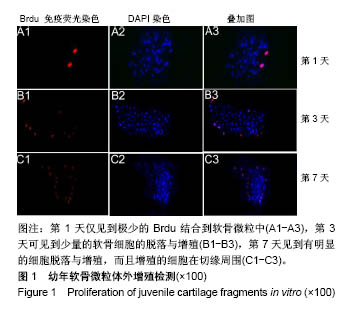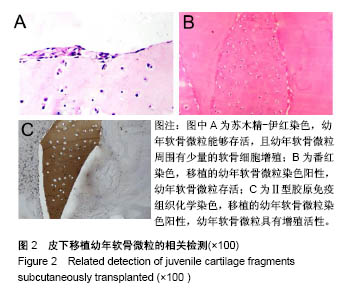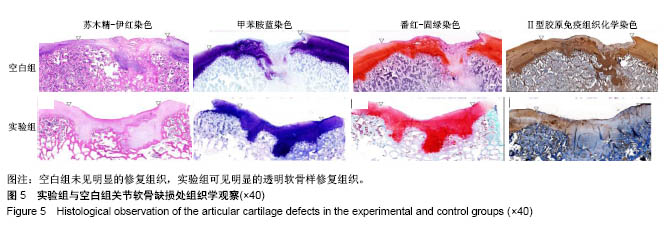| [1] Schindler OS.Current concepts of articular cartilage repair. Acta orthop Belg. 2011;77(6):709-726.[2] Min BH,Choi WH,Lee YS,et al.Effect of different bone marrow stimulation techniques (BSTs) on MSCs mobilization.J Orthop Res. 2013;31(11):1814-1819.[3] Bedi A,Feeley BT,Williams RJ.Management of Articular Cartilage Defects of the Knee. J Bone Joint Surg Am. 2010; 92(4):994-1009.[4] Perterson L,Minas T,Brittberg M,et al.Two-to-9-year outcome after autologous chondrocyte transplantation of the knee.Clin Orthop Relat Res.2000;374:212-214.[5] Haddo O,Mahroof S,Higgs D,et al.The use of chondrogide membrane in autologous chondrocyte implantation.The knee. 2004;(11)1:51-55.[6] Filardo G,Kon E,Di Martino A,et al.Second-generation arthroscopic autologous chondrocyte implantation for the treatment of degenerative cartilage lesions.Knee Surg Sports Traumatol Arthrosc. 2012;20(9):1704-1713.[7] Kon E,Delcogliano M,Filardo G,et al.A novel nano-composite multi-layered biomaterial for treatment of osteochondral lesion:technique note and an early stability pilot clinical trial. Injury. 2010;41(7):693-701.[8] Gille J,Behrens P,Schulz AP,et al.Matrix-Associated Autologous Chondrocyte Implantation: A Clinical Follow-Up at 15 Years. Cartilage.2016;7(4):309-315.[9] Karoubi G, Ormiston ML,Stewart DJ,et al. Single-cell hydrogel encapsulation for enhanced survival of human marrow stromal cells. Biomaterials.2009;30(29):5445-5455.[10] Shimizu H,Ohashi K,Utoh R,et al.Bioengineering of a functional sheet of islet cells for the treatment of diabetes mellitus. Biomaterials. 2009;30(30):5943-5949.[11] Hayashi S,Kamei N,Ikuta Y,et al.Chondrocyte cell-sheet transplantation for treating monoiodoacetate-induced arthritis in rats. Tissue Eng Part C Methods.2017;23(6):346-356.[12] Xu X,Shi D,Liu Y,et al.Synovium-derived mesenchymal stem cell sheet enhance autologous osteochondral transplantation in a rabbit momdel. Int J Clin Exp Med. 2016;9(6):10322-10332.[13] Shaari CM,Farber D,Brandwein MS,et al.Chracterizing the antigenic profile of the human trachea:Implications for tracheal transplantation.Head Neck.1998;20(6):522-527 [14] Liu K,Zhou GD,Liu W,et al.The dependence of in vivo stable ectopic chondrogenesis by human mesenchymal stem cells on chondrogenic differentiation in vitro. Biomaterials. 2008;29(14): 2183-2192.[15] Ge Y, Gong YY,Xu Z,et al.The application of sheet technology in cartilage tissue engineering.Tissue Eng Part B Rev. 2016; 22(2):114-124.[16] Mouthuy PA,Elsherbini Y,Cui Z,et al.Layering PLGA-based electrospum membranes and cell sheets for engineering cartilage-bone transition.Tissue Eng Regen Med. 2016;10(4): 263-274.[17] Verdonk P,Dhollander A,Almqvist KF,et al.Treatment of osteochondral lesions in the knee using a cell-free scaffold. Bone Joint J. 2015;97-B(3):318-323.[18] Brix M,Kaipel M,Kellner R,et al. Successful osteoconduction but limited cartilage tissue quality following osteochondral repair by a cell-free multilayered nano-composite scaffold at the knee. Int Orthop. 2016;40(3):625-632.[19] Filardo G,Kon E,Di MA,et al.Treatment of knee osteochondritis dissecans with a cell-free biomimetic osteochondral scaffold: clinical and imaging evaluation at 2-year follow up.am J Sports Med. 2013;41(8):1786-1793.[20] Albrecht F,Roessner A,Zimmermann E.Closure of osteochondral lesions using chondral fragments and fibrin adhesive. Arch Orthop Trauma Surg.1983;101(3):213-217.[21] Riboh JC,Cole BJ,Farr J.Particulated articular cartilage for symptomatic chondral defects of the knee.Curr Rev Musculoskelet Med.2015;11(1):21-34.[22] Bonasia DE,Marmotti A,Rosso F,et al.Use of chondral fragments for one stage caitilage repair:a systematic review. World J Orthop. 2015;6(11):1006.[23] 宁志刚,杨柳,王富友,等.保留钙化层结构的猪股骨滑车全厚软骨缺损模型建立[J].中国修复重建外科杂志,2012,26(5):527-531.[24] Brittberg M,Aglietti P,Gambardella R,et al.ICRS Cartilage Injury Evaluation Package. 2002:16-18. https://www.secot.es/ uploads/descargas/formacion/escalas_valoracion/ICRS._TRAUMA_CARTaILAGO.pdf [25] Mainil-Varlet P,Aigner T,Brittberg M,et al.Histological assessment of cartilage repair: a report by the Histology Endpoint Committee of the International Cartilage Repair Society (ICRS). J Bone Joint Surg Am. 2003;85-A 2(1):45-57.[26] Kontturi LS,Jarvinen E,Muhonen V,et al.An injectable,insitu forming type IIcollagen/hyaluronic acid hydrogel vehicle for chondrocyte delivery in cartilage tissue engineering.Drug Deliv Transl Res. 2014;4(2):149-158.[27] Cole BJ,Farr J,Winalski CS,et al.Outcomes after a single-stage procedure for cell-based cartilage repair: a prospective clinical safety trial with 2-year follow-up.Am J Sports Med. 2011;39(6): 1170-1179.[28] Kon E,Filardo G,Zaffagnini S,et al.Biodegradable polyurethane meniscal scaffold for isolated partial lesions or as combined procedure for knees with multiple comorbidities: clinical results at 2 years. Knee Surg Sports Traumatol Arthrosc. 2014;22(1): 128-134.[29] Farr J,Yao JQ.Chondral Defect Repair with Particulated Juvenile Cartilage Allograft. Cartilage. 2011;2(4):346-353.[30] Farr J,Tabet SK,Margerrison E,et al.Clinical,Radiographic,and histological outcomes after cartilage repair with particulated juvenile articular cartilage:a 2-year prospective study.Am J Sports Med. 2014:42(6):1417.[31] Mcmillan S,Light GT, Brtz C.All-arthroscopic implantation of minced juvenile chondral allograft for an isolated, full-thickness chondral lesion in the trochlea of an adult knee. Arthrosc Tech. 2016;5(2):397-401.[32] Arshi A,Wang D,Jones KJ.Combined particulated juvenile cartilage allograft transplantation and medial patellofemoral ligament reconstruction for symptomatic chondral defects in the setting of recurrent patellar instability.Arthrosc Tech. 2016;5(5): 1149-1154.[33] Buckwalter JA,Bowman GN,Albright JP,et al.Clinical outcomes of patellar chondral lesions treated with juvenile particulated cartilage allografts.lowa Orthop J. 2013;34(1)44-49.[34] Kruse DL,Ng A,Paden M,et al.Athroscopic De Novo NT(R) juvenile allograft cartilage implantation in the talus: a case presentation.J Foot Ankle Surg.2012;51(2):218.[35] Dunn JC,kusnezov N,Orr J,et al.Ostochondral defects of the upper extremity treated with particulated juvenile cartilage transfer. HAND. 2015;10(4):683-687.[36] Pascual-Garrido C,Hao J,Schrock J,et al.Arthroscopic juvenile allograft cartilage implantation for cartilage lesions of the hip. Arthrosc Tech. 2016;5(4)929-933.[37] Adkisson HD,Martin JA,Amendola RL,et al.The potential of human allogeneic juvenile chondrocytes for restoration of articular cartilage. Am J Sports Med.2010;38(7):1324-1333.[38] Smeriglio P,Lai JH,Dhulipala L,et al.Comparative potential of juvenile and adult human articular chondrocytes for cartilage tissue formation in three-dimensional biomimetic hydrogels. Tissue Eng Part A. 2015;21(1-2)147-155.[39] Skaalure SC,Milligan IL,Bryant SJ.Age impacts extracellular matrix metabolism in chondrocytes encapsulated in degradable hydrogels. Biomed Mater.2012;7(2):024111.[40] Bonasia DE,Martin JA,Marmotti A,et al.Cocultures of adult and juvenile chondrocytes compared with adult and juvenile chondral fragments: in vitro matrix production.Am J Sports Med. 2011;39(11):2355-2361.[41] Marmotti A,Bonasia DE,Bruzzone M,et al.Human cartilage fragments in a composite scaffold for single-stage cartilage repair:an in vitro study of the chondrocyte migration and the influence of TGF-beta1 and G-CSF.Knee Surg Sports Traumatol Arthrosc.2013;21(8):1819-1833.[42] Adkisson HD,Milliman C,Zhang X,et al.Immune evasion by neocartilage-derived chondrocytes: Implications for biologic repair of joint articular cartilage.Stem Cell Res. 2010;4(1): 57-68.[43] Tompkins M,Adkisson HD, Bonner KF. DeNovo NT Allograft. Oper Tech Sports Med. 2013;21(2):82-89. |
.jpg)





.jpg)